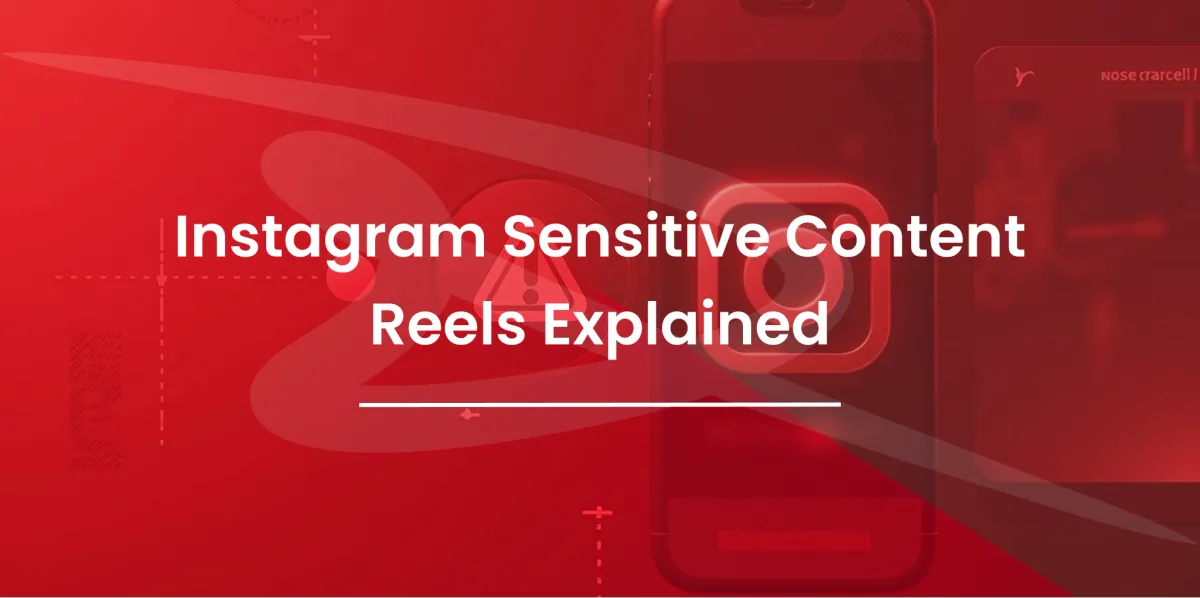Instagram Sensitive Content Reels – Control & Filter Settings
Instagram Reels has rapidly become a dominant feature of the Instagram app, offering users a way to share short-form videos. However, concerns over Instagram sensitive content reels have grown due to an increase in graphic content and violent content appearing in users' Instagram Reels feed.

Introduction
Instagram Reels has rapidly become a dominant feature of the Instagram app, offering users a way to share short-form videos. However, concerns over Instagram sensitive content reels have grown due to an increase in graphic content and violent content appearing in users' Instagram Reels feed. Many Instagram users have reported encountering disturbing videos that go against community guidelines, raising concerns about Meta's policy on content recommendations.
To address these issues, Instagram has implemented features such as the Sensitive Content Control setting, designed to help users manage what they see. But does this setting effectively limit sensitive content, or is there still a sudden surge of inappropriate material? Let’s dive into how social media platforms like Instagram handle NSFW content, the algorithm change influencing recommendations, and how users can take control of their experience.
Understanding Sensitive Content on Instagram

Instagram defines sensitive content as any material that includes graphic violence, sexual activity, or hate speech. While this type of Instagram post may not always violate Recommendation Guidelines, it is often flagged for being inappropriate for certain audiences. Examples of such content include:
- See-through clothing or suggestive imagery.
- Videos depicting pharmaceutical drugs or their usage.
- Content related to human rights violations.
- Misinformation linked to Donald Trump or Elon Musk, which is often scrutinized for spreading false narratives.
To tackle these challenges, Instagram employs Artificial Intelligence to detect and flag potentially much sensitive content before it reaches a broad audience. However, the effectiveness of this system remains questionable, as content recommendations sometimes still showcase flagged videos in users’ Instagram feed.
Instagram’s Sensitive Content Control Feature
In response to user concerns, Instagram introduced the Sensitive Content Control setting in the Settings menu. This feature allows users to choose how much sensitive content warning they want to see in their Instagram account. The three options available are:
- Standard – The default setting, which limits some sensitive content.
- More – Allows more sensitive content to appear in the Instagram Reels feed.
- Less – Further restricts exposure to potentially inappropriate material.
To adjust these settings:
- Go to your Settings menu.
- Click on Sensitive Content Control setting.
- Choose between Standard, More, or Less.
- Tap Copy link to share information about this setting with others.
Despite this new feature, some Instagram users claim that even when selecting the Limit sensitive content option, much sensitive content still appears. This has raised further concerns about whether Instagram’s algorithm change has made it harder to filter out inappropriate material.
Recent Surge in Sensitive Content on Reels
Recently, users have noticed a sudden surge in violent content and graphic violence on their Instagram feed. This has led to frustration and confusion, with many questioning if Meta's policy on content recommendations is failing.
A Meta spokesperson addressed these concerns, stating that an internal algorithm change may have unintentionally promoted such content. However, many believe this explanation is inadequate, given the continuous reports of users encountering disturbing videos despite adjusting their Sensitive Content Control setting.
Additionally, many have resorted to reporting inappropriate posts via the Help Center, but the results have been inconsistent. Some posts get removed quickly, while others remain visible for extended periods. This has led to concerns about whether Instagram’s moderation efforts are effective or if NSFW content is slipping through the cracks.
Meta’s Response to Content Moderation Issues
Meta has acknowledged the sensitive content issue and promised improvements in its AI-powered content moderation. However, critics argue that relying on artificial intelligence alone is not enough to tackle harmful content. Users have repeatedly pointed out that content filtering mechanisms sometimes fail, exposing them to inappropriate videos.
The algorithm update meant to enhance content ranking seems to have played a role in amplifying certain controversial posts. Many social media users believe that instead of prioritizing safe content, Instagram’s explore page and Reels suggestions have inadvertently surfaced graphic violence, making it difficult to control exposure.
User Experiences and Community Feedback
The Instagram community has expressed mixed reactions regarding content control measures. While some users have successfully used the filter settings, others claim they are ineffective in blocking sensitive videos.
Platforms like Reddit and Twitter are flooded with complaints about users being forced to see disturbing clips, even after marking content as inappropriate. Some have resorted to third-party tools to block certain topics, highlighting a growing dissatisfaction with Instagram’s built-in content filtering mechanisms.
Users are also concerned about how Instagram Reels algorithms work. Many believe the focus on engagement-driven content has led to the increased spread of controversial and shocking material, making it harder for content creators to produce safe, ad-friendly content.
Best Practices for Users to Manage Content Exposure
To reduce exposure to graphic content and take better control of your Instagram experience, consider these best practices:
- Regularly update content preferences – Use the Sensitive Content Control setting to minimize exposure.
- Report inappropriate posts – Use the Help Center to notify Instagram about harmful content.
- Customize your Explore Page – Avoid interacting with sensitive material so that Instagram’s algorithm does not recommend similar videos.
- Use third-party blocking tools – If necessary, explore browser extensions that help filter out unwanted material.
- Monitor your child’s Instagram activity – If you’re a parent, set up parental controls to ensure they are not exposed to NSFW content.
Conclusion
Instagram’s efforts to manage sensitive content through content moderation policies and artificial intelligence are still evolving. While features like Sensitive Content Control provide some level of protection, many users feel that content filtering mechanisms need further refinement.
As Instagram continues updating its algorithm and content policies, users must stay informed and take advantage of available tools to control their feed. By being proactive in adjusting content preferences, reporting problematic content, and utilizing additional safety measures, Instagram users can create a more personalized and safe browsing experience.
With social media’s growing influence, content responsibility remains a shared duty between platforms, users, and regulators. The challenge ahead is ensuring that sensitive content policies balance freedom of expression with user safety, making Instagram Reels a more secure space for all.




Comments ()